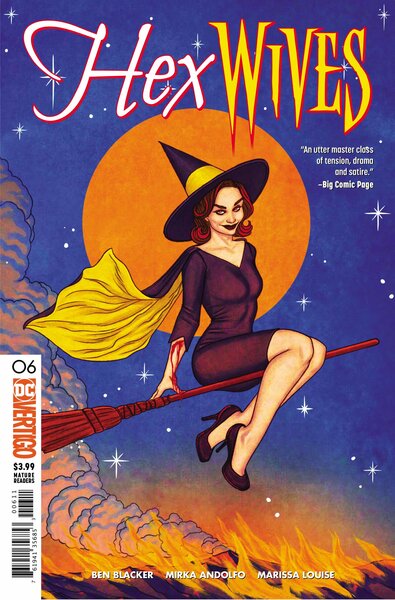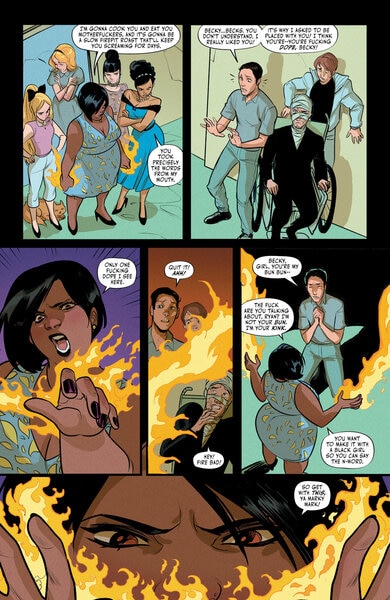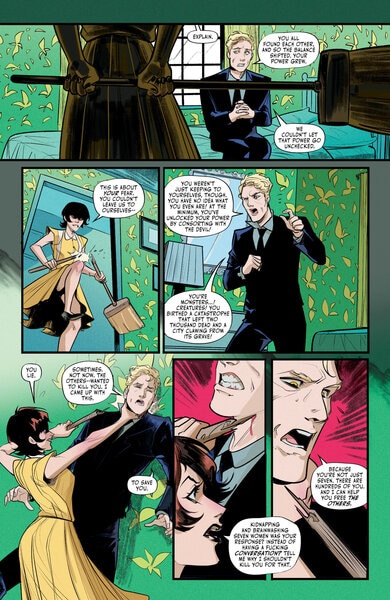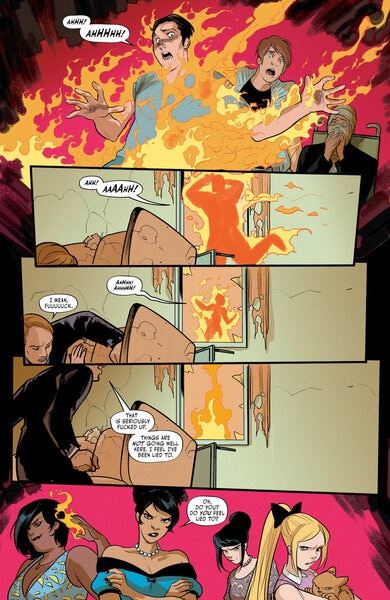Create a free profile to get unlimited access to exclusive videos, sweepstakes, and more!
Exclusive preview: Hex Wives ends with a bang in Issue 6
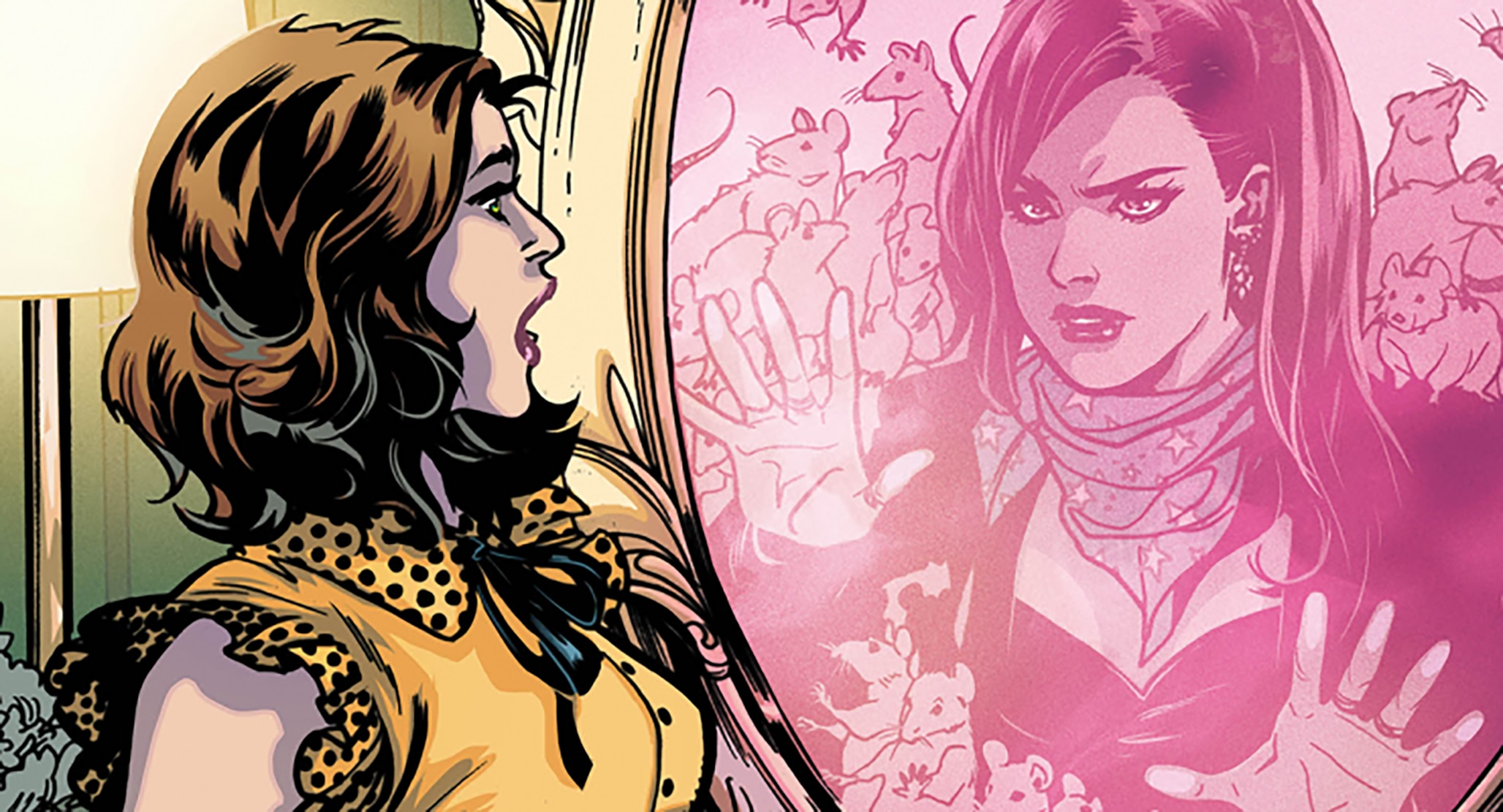
What if, rather than being slowly subjugated and replaced by robots, The Stepford Wives had actually gotten to fight back against their oppressors? What if Samantha from Bewitched had joined a coven and bounced on suburbia? What if Offred in The Handmaid's Tale had been a witch with incredible power who freed herself in the first 20 pages of the book? The answer to these queries is more or less the central plot of Hex Wives, written by Ben Blacker and co-developed with artist Mirka Andolfo.
Their answer? The women would join together, take their revenge, set things on fire, and emerge as an unstoppable united force. Sounds pretty good to us.
Issue 6 will mark the end of the Hex Wives story for the time being, and we've got an exclusive look at the issue. The last few months have seen countless interviews and reviews of the series, and many of them have been overwhelmingly positive. Indeed, this is a story that announces its intentions at the outset and doesn’t lose sight of them for a moment. In the first issue we learned that two women, Isadora Roma and her lover Nadiya Momo, have been engaged in centuries of battle against the Architects, who, for the purposes of the story, are essentially the patriarchy given form. They hoard power and fear that the rise of women in societal power structures would uncover their own inadequacies and leave them purposeless and useless. This will all sound pretty familiar to people who live in, you know, reality, but it calls back on dystopian sci-fi tropes as well, echoing everything from The Handmaid’s Tale to Logan’s Run.The coven that Isadora and Nadiya belong to lose their memories and are subjugated by the Architects in the form of Stepford-esque wives to the men who have worked through the centuries to oppress them. The series focuses on the women as they slowly relearn what they have lost and start reclaiming their identities. After decades of watching stories in which women lose power as part of the moral of the tale, Hex Wives is the comic that throws that ending off the table, then sets the whole table on fire and walks off. Sound good? We liked it, too.
Vertigo’s longstanding inclination for reimagining old concepts in a way that inverts their tropes to make them relevant to modern audiences while remaining seeped in callbacks to anything from old Twilight Zone episodes to obscure mythology is prominently on display with the series, and it fits in nicely with the more recent releases of DC’s darker, edgier line. Though always groundbreaking, the early Vertigo stories were prominently focused on male protagonists and creative teams, and series like Hex Wives are slowly shifting the tide.Here, specifically in the final issue, we see prominent use of the old words that have been used to put women in their place. The witches are referred to as hysterical by the Architects, who insist no one will believe them or respect their power. Standard, seemingly benign takes from the modern lexicon are utilized, for instance, in the case of the “man cave," a sinister domain in which the men plot against women. Knowledge of the potential for oppression that is hidden in our everyday language becomes a not-so-subtle tool of supervillainy.
To look back at the inspirations for Hex Wives, the first lines of The Stepford Wives book are a quote by Simone de Beauvoir that reads, “Today the combat takes a different shape; instead of wishing to put a man in a prison, woman endeavors to escape from one; she no longer seeks to drag him into the realms of immanence but to emerge, herself, into the light of transcendence. Now the attitude of the males creates a new conflict: it is with a bad grace that the man lets her go.” This is a fair assessment also of the Hex Wives plot, but the difference is that our characters live long enough to see the fall of the men whose “bad grace” is the central conflict. The story revolutionizes simply by repositioning the trope. Here, we see what we wished would happen after the final pages of The Stepford Wives.
For longtime genre fans who read the horror novels of Ira Levin growing up, Hex Wives will read as a cathartic moment that took more than 40 years to arrive. Books by Levin are considered early examples of horror stories in which a male writer expressed his own concerns about the challenges facing the modern Women’s Liberation movement, but as we know, their female characters fare very poorly. In The Stepford Wives specifically, protagonist Joanna Eberhart helplessly watched as her friends were all replaced by robots until her own husband finally sided fully with the shadowy patriarchy of the Stepford township. Her last moments are full of horror as she sees herself fully betrayed by a husband who would prefer her to be a robot rather than a real-life woman, with all the strengths and flaws and surprises that would bring.
In Hex Wives, the male characters absolutely try to do just that, but with the introduction of another exploitation horror era favorite, witches, they meet their comeuppance over the six issues of the series. Issue 6 gives us all the moments of violent catharsis that have been hinted and built toward. The characters that we have grown increasingly angry with as the story built are finally taken out of power, and the witches find a stronger family with one another.
Though revenge fantasies are a dime a dozen, it’s important to note that this is a modernized take on the old tale with a clearer intention of purpose. We don’t know what will happen to our coven next, but in all fairness, neither do they. Haircuts and wardrobe changes abound as the women fiercely reassert their own independence after languishing in varying degrees of sorrow and rage through much of the story.
From the outset, this is a comic that was dubbed as a revenge fantasy, one desperately needed by modern audiences who have grown exhausted with the trials and tribulations of living in a world defined by rich white men. The villains here actually look like the villains we see in the news: the attractive blond man who speaks with more confidence than a single person could ever earn, the seemingly sympathetic guy who manipulates and controls the most vulnerable women, the group of men who band together to gaslight and oppress. The acknowledgment that their power is stolen and never given is the center of the story, and the anger at that injustice is what gives Hex Wives all its flavor.So, is Hex Wives really a feminist revenge story for the ages? Of course, only time and individual perspectives will say, but the art is fantastic, the rotating cover artists provided iconic imagery to draw us in with, and the plot and intention of the story are crystal clear. For women who have grown weary of constant, unending microaggressions and being treated as second-rate citizens in their own homes by the men who claim to love them above all, Hex Wives is a refreshing about-face. We’ve seen the coven lose and be defeated many, many times in the horror genre, we’ve seen the coven fight among themselves, and we’ve seen them give up the coven entirely for a bleak life in suburbia with a frustratingly average husband, but we’ve seldom seen the coven truly rise up and claim their power. Time and again, Hex Wives delivers.
